Coral Reef
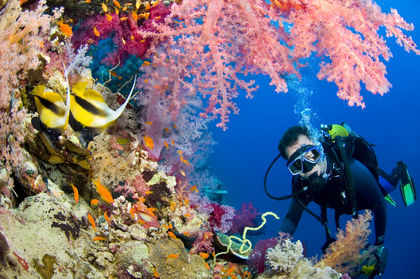
Coral reefs are not only spectacular marine environments, but they are one of the oldest ecosystems (community of plants and animals interacting with their environment) on Earth. They are created by colonies of organisms called coral polyps (pronounced PAH-lips). Among biological organisms, only humans have the ability to alter the surface of the planet more than these tiny marine creatures. Over thousands to millions of years, they may form massive structures of limestone that alter the shoreline of continents.
Although coral reefs cover 0.2 percent of the total area of the oceans, they are critically important for a diversity of marine species. They provide a habitat for at least 25 percent of all marine animals, including sponges, more than 4,000 different species of fish, anemones, sea stars, crabs and other crustaceans, and clams and other mollusks. Home to so many different species, coral reefs are often referred to as the "rainforests of the oceans." They also provide physical barriers to the force of strong waves, protecting beaches, lagoons, and other coastal features lying behind them. Yet they are highly vulnerable to pollution, an increase in water temperature, and damage from tourism and coastal development. By the early twenty-first century, these threats had already claimed more than one-quarter of the world's coral.
The shape of the land
A coral reef is a wave-resistant limestone structure produced by living organisms, found principally in shallow, tropical marine waters. Limestone is a type of rock composed primarily of the mineral calcite, which is a crystalline form of calcium carbonate (CaCO 3 ). Thousands of species inhabit coral reefs, but only a fraction produce the calcium carbonate that crystallizes into the limestone that forms the reef.
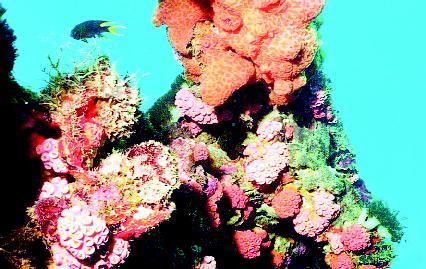
Coral polyps are the most important reef-building organism. The species that secrete calcium carbonate are known as hard coral polyps or, simply, stony corals. In the western Pacific Ocean, more than three hundred species of stony corals exist. Coral polyps are invertebrates (pronounced in-VER-tuh-brets), or animals without backbones. They are related to anemones and jellyfish. In fact, a coral polyp looks similar to an anemone: it is a jellylike sac attached at one end to its skeleton. The open end, the mouth, is fringed with six stinging tentacles (or a multiple of six), which the polyp extends at night to feed. The size of coral polyps varies greatly, depending on the species. They may be as small as 0.04 inch (0.1 centimeter) in diameter or as large as 8 inches (20 centimeters) in diameter.
Worldwide, coral reefs cover an estimated 110,000 square miles (284,900 square kilometers). Many stony corals grow best in clear, salty water with a temperature between 70°F and 85°F (21°C and 29°C). Because of this, most reefs are found in the Pacific Ocean, the Caribbean Sea, the Red Sea, the Arabian Sea, and the Indian Ocean between the tropic of Cancer and the tropic of Capricorn, two parallel lines of latitude lying one-quarter of the way from the equator to the North and South Poles, respectively. Reefs are also found around Florida and southern Japan because warm-water currents flow into these areas from the Tropics.
The shape of a coral reef depends on the species of coral building it. Different types of coral produce different shapes. Some are pointed and hard; others are round and soft. They may be robust or delicate. Various shapes in reefs include fingerlike branches, flat branches, knobs or wedges, boulders or balls, mushroom caps, and tablelike structures.
Coral reef: Words to Know
- Atoll:
- A ring-shaped collection of coral reefs that nearly or entirely encloses a lagoon.
- Back reef:
- The landward side of a reef between the reefcrest and the land.
- Barrier reef:
- A long, narrow ridge of coral relatively near and parallel to a shoreline, separated from it by a lagoon.
- Coral polyp:
- A small, invertebrate marine animal with tentacles that lives within a hard, cuplike skeleton that it secretes around itself.
- Ecosystem:
- A system formed by the interaction of a community of plants, animals, and microorganisms with their environment.
- Fore reef:
- The seaward edge of a reef that is fairly steep and slopes down to deeper water.
- Fringing reef:
- A coral reef formed close to a shoreline.
- Invertebrates:
- Animals without backbones.
- Lagoon:
- A quiet, shallow stretch of water separated from the open sea by an offshore reef or other type of landform.
- Limestone:
- A sedimentary rock composed primarily of the mineral calcite (calcium carbonate).
- Photosynthesis:
- The process by which plants use energy from sunlight to change water and carbon dioxide into sugars and starches.
- Reef crest:
- The high point of a coral reef that is almost always exposed at low tide.
- Symbiosis:
- The close, long-term association between two organisms of different species, which may or may not be beneficial for both organisms.
- Zooxanthellae:
- Microscopic algae that live symbiotically within the cells of some marine invertebrates, especially coral.
Most coral reefs are brightly colored, but that color does not come from the coral polyps themselves. In fact, the bodies of the tiny creatures are clear. The calcium carbonate they produce to form their external skeleton is white, much like the bones of a human skeleton. Reef colors come from the microscopic, single-celled algae called zooxanthellae (pronounced zoe-ah-zan-THEL-ee) that live in the tissue of the coral. Zooxanthellae and coral polyps have what is termed a symbiotic (pronounced sim-bee-AH-tik) relationship. Symbiosis is the close, long-term association between two organisms of different species, which may or may not be beneficial for both organisms. In the case of the zooxanthellae and coral polyps, the relationship benefits both. The algae provide the coral polyps with more than 90 percent of their nutrients, and the coral polyps provide the algae with essential minerals and a protected habitat. Their unique relationship allows coral reefs to exist and grow year after year.
Coral reefs are generally divided into three classes: fringing reefs, barrier reefs, and atolls (pronounced A-toles). The simplest and most common type of coral reef, fringing reefs, form close to the shoreline of islands and continents. A shallow lagoon, a quiet stretch of water separated from the open sea, may or may not lie between the shoreline and the fringing reef. Barrier reefs also form parallel to the shoreline of an island or a continent, but farther away than fringing reefs. In addition, they are larger and may stretch for great distances. Wide, deep lagoons often separate barrier reefs from the shoreline. Atolls are ring-shaped coral reefs that enclose or nearly enclose a deep lagoon. They are typically found around islands that have sunk beneath sea level in the deep ocean. These islands are often the tops of underwater volcanoes. On the lagoon side of atolls, sediment from broken coral may collect and partially fill the lagoon, allowing vegetation to grow. Eventually, the entire lagoon may be filled in, forming an island that may become inhabited. Atolls such as this are common in the Indian and Pacific oceans.
Forces and changes: Construction and destruction
Geologists have discovered that ancient corals existed on Earth as long ago as 400 million years. Present-day stony corals evolved over the last 25 million years. Most established coral reefs are between 5,000 and 10,000 years old. Although they are the largest structures of biological origin on the planet and represent thousands of years of history, coral reefs are extremely delicate. Their formation takes place only under certain conditions.
Corals reproduce two ways. They may do so sexually by releasing eggs and sperm. Once fertilized, the eggs produce multitudes of free-swimming larvae (pronounced LAR-vee; immature forms of the coral polyps) that ocean currents carry great distances. After settling on a suitable hard surface, the larvae secrete their own calcium carbonate cups and grow into mature corals, thus forming a new colony and a new reef. Corals may also reproduce asexually by budding or forming new coral polyps attached to themselves by thin sheets of tissue and skeletal material. Through budding, a single coral polyp can develop over time into a massive coral head.
The hard, cuplike skeleton that a coral secretes around itself from its lower portion consists of clusters of calcium carbonate, one of the most common minerals on Earth. In order to produce calcium carbonate, stony corals need the assistance of zooxanthellae, which live within cells in the lining of a coral polyp's gut. A polyp not only provides the zooxanthellae
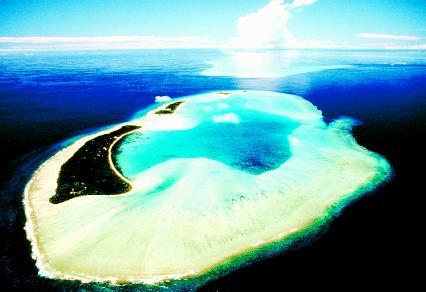
with a protected environment but with carbon dioxide and nutrients that the polyp gives off as waste products. In return, the zooxanthellae use the carbon dioxide to provide the coral polyp with nutrients, including glucose (sugar) and amino acids, through photosynthesis (pronounced foetoe-SIN-thih-sis). Photosynthesis is the process by which plants use energy from sunlight to change water and carbon dioxide into sugars and starches. The polyp uses the compounds supplied by the zooxanthellae to create proteins, fats, carbohydrates, and calcium carbonate.
Sunlight and clear water
Since zooxanthellae need sunlight in order to photosynthesize, corals flourish in waters less than 230 feet (70 meters) deep. Maximum growth rates occur when the coral is in water less than 60 feet (18 meters) deep. Corals may grow at deeper depths, sometimes up to 300 feet (91 meters), but their ability to produce calcium carbonate is greatly reduced. As a result, they grow poorly. The growth rate of corals is also reduced if the water is murky and sunlight is not able to penetrate. Water temperature and the amount of salt in the water also affect growth rate. Corals may grow in water slightly below 70°F (21°C) and slightly above 85°F (29°C), but that growth is very slow. Stony corals also prefer waters where the salt concentration ranges between 32 and 42 parts per thousand. The concentration of oxygen in the water must also remain high.
When optimum conditions are present, corals may grow as much as 1.7 inches (4.5 centimeters) per year. Different species grow at different rates. In general, the larger the coral, the slower the growth. Very large corals may grow only 0.2 to 0.8 inch (0.5 to 2 centimeters) per year. Branching corals may grow much faster, up to 8 inches (20 centimeters) per year. Because of their fast growth rate and their treelike structure, branching corals are prone to damage from strong storm waves, which may break off their branching limbs. Large, dense corals are much more stable and less prone to damage from wave action.
While a coral polyp is alive, it periodically rises up in its cuplike skeleton and secretes more calcium carbonate to form a new base or floor. In this way, the polyp enlarges its skeleton, creating chambers underneath its base. When a polyp dies, its skeleton remains, becoming the foundation on which a new polyp attaches and builds its skeleton. Coral reefs are composed of layer upon layer of polyp skeletons, sometimes numbering in the billions. Only the thin, top layer contains living coral polyps.
Other creatures add to the complex structure of a coral reef. A type of red algae known as coralline algae contribute to the framework of reefs by secreting their own encrusting skeleton that helps cement loose sediment on the reef. Other organisms that contribute reef sediments include sponges, clams, and snails. These marine creatures live in the holes and crevices of the reef. When they die, their remains provide a foundation for new coral polyps.
Reef structure and forms
Coral reefs remain underwater except when water levels periodically decrease, such as at low tides. At this time, only the highest part of the coral reef, the reef crest, is exposed, washed over by waves. Coral polyps that exist and grow on this section of a reef must be able to tolerate the Sun's heat and wave action. In order to do so, they generally grow in plate-like, stubby branching or massive structures. The upper surface is often encrusted with coralline algae.
Corals that exist on the reef seaward from the reef crest are diverse and show the greatest range of forms. In areas where wave energy is still high, massive corals are predominant. As the reef angles deeper and deeper beneath the water's surface, delicate branching corals take over. The outermost seaward slope is called the fore reef. It may angle down to the sea bottom by as much as 30 degrees. The fore reef consists of limestone boulders, coral branches, and smaller sediments. It may have deep channels cut into it, forming fingerlike structures that extend seaward from the reef. These help stabilize the reef and cut down the force of incoming strong waves.

Darwin and Atoll Formation
While traveling aboard the H.M.S. Beagle in the mid-1830s, English naturalist Charles Darwin (1809–1882) devised the modern theory of coral atoll formation. Although widely known for his theory of evolution by natural selection, Darwin made many contributions to the science of geology. His theory of coral reefs is his best-known.
Darwin proposed that fringing reefs, barrier reefs, and atolls represented a series through geologic time. He held that the transition from fringing reef to barrier reef to atoll could result from the upward growth of coral on the edge of a gradually sinking volcano. He believed that barrier reefs represented a middle stage between fringing reefs and atolls, and that the ringlike appearance of an atoll with a central lagoon resulted from the total submergence of the summit of a volcano.
In the 1950s, scientists from the U.S. Geological Survey, an earth science research and information agency, undertook extensive drilling programs on atolls in the Pacific Ocean. Hundreds of feet down, they encountered volcanic rock, proving Darwin's theory that atolls are perched over ancient submerged volcanoes.
The area lying landward of the reef crest is known as the back reef. Sand and other fine-grained sediment often inhibit reef growth in this area, so various other marine organisms dominate. However, scattered stubby, branching, or low knobby corals may develop in water as shallow as 3 feet (1 meter). Beyond the back reef, the water begins to deepen again, to as much as 100 feet (30 meters) or more, within the lagoon. Protected from the full force of waves, the lagoon floor is smooth and fine-grained.
While fringing and barrier reefs are common on the submerged portions of continents, atolls are not. Atolls formed in the deep ocean around submerged submarine volcanoes. They began to grow as a small fringing reef around the shoreline of a volcanic island. Once the volcano had become extinct, the sea floor beneath it may have begun to subside or sink under the weight of the volcano. As the island slowly submerged over millions of years, the corals continued to grow upward to the surface of the water, keeping pace with the rate the island was sinking. The sides of some atolls reach depths as great as 1,500 feet (457 meters). Eventually, as the island slipped beneath the ocean's surface, a ring of coral reefs remained, surrounding a central lagoon.
Cold-water Corals
Most well-known corals exist in tropical coral reefs, but reef-forming corals also exist in deep, cold water. Known as Lophelia, these corals lack zooxanthellae, so they do not depend on sunlight for survival. Instead, they feed by capturing food particles with their tentacles from the surrounding water. They are found at depths ranging from 230 to 3,280 feet (70 to 1,000 meters). These types of corals grow slower than their warm-water relatives, averaging 0.04 inch (0.1 centimeter) per year.
The largest known Lophelia coral reef is found off central Norway at a depth of about 1,312 feet (400 meters). It measures almost 9 miles (14 kilometers) in length and 2 miles (3 kilometers) in width. It stands almost 98 feet (30 meters) in height.
Cold-water corals are found throughout the western Atlantic Ocean from Nova Scotia to Brazil. They are also found in the eastern Atlantic, the Mediterranean Sea, the Indian Ocean, and eastern Pacific Ocean. Like warm-water reefs, Lophelia coral reefs support very rich communities of fish, shrimps, and other invertebrates.
Some atolls formed when sea levels rose, submerging the tops of islands. The rise and fall of the sea level over the past few million years has been caused by changes in the volume of water tied up in land glaciers and ice sheets during the ice ages. When ice sheets grew in the Northern Hemisphere, the sea level dropped and coral reefs such as atolls were stranded above the waterline. Since present-day water levels have not risen to what they were before the last ice age, which ended approximately 10,000 years ago, the tops of many atolls have remained exposed.
Reef damage
While coral reefs may be damaged by natural forces such as storms and hurricanes, they suffer the severest damage from human activity. Reefs are often destroyed by collectors who use coral to create jewelry and by fisherman who use poison or dynamite to catch fish around coral reefs. Because corals need sunlight and sediment-free water to survive, water pollution poses a grave danger. Oil spills, the dumping of sewage wastes, and the runoff of soil and agricultural chemicals such as pesticides all threaten the delicately balanced ecosystem of coral reefs.
Global warming, an increase in the world's temperatures, is the biggest threat facing coral reefs. It is thought to be caused, in part, by the burning of fossil fuels and the depletion of the ozone layer, both brought about through human activities. Scientists believe a warming of water temperature, by even just a few degrees, can cause coral polyps to expel the zooxanthellae living inside them. This results in coral bleaching, which is the whitening of coral colonies due to the loss of the zooxanthellae. The end result is death of the coral. While pollution and changes in the salt content of the water can also bring about coral bleaching, warmer sea temperatures seem to be the biggest culprit. Natural occurrences, such as El Niño (the irregular periods during which the normally cold waters off the coast of Peru are made warmer by the arrival of warm waters from the equatorial region), have been blamed for some coral bleaching. However, these events are short-lived. Global warming is not.
Spotlight on famous forms
Great Barrier Reef, off the northeastern coast of Australia
The Great Barrier Reef, situated off Queensland state in Australia's northeast, is the largest structure on the planet created by living organisms. Approximately 1,250 miles (2,011 kilometers) in length, the coral reef consists of more than 2,800 individual detached reefs, separated by deep channels. It is separated from the Australian shoreline by a shallow lagoon that varies from 10 to 100 miles (16 to 161 kilometers) in width. At its widest, the reef measures 45 miles (72 kilometers) across. It covers roughly 80,000 square miles (207,200 square kilometers), an area approximately as large as the state of Kansas. The reef can be seen from space and was first mapped by Apollo 7 astronauts in 1968.
Geological evidence shows the reef began growing more than 25 million years ago. Its age and size are due to the very stable geological setting of the area off the Australian continent and the favorable circulation of oceanic water. Winds in the area help stir the water, keeping it a relatively constant warm temperature regardless of depth.
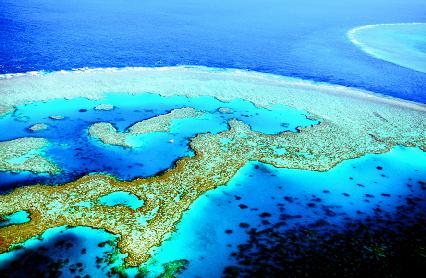
The reef is home to millions of living creatures. More than 350 species of stony corals make up the reef. Countless other organisms inhabit the area, including more than 1,500 species of fish, 4,000 species of mollusks, 200 species of birds, as well as varieties of dolphins, whales, green turtles, and dugongs or "seacows."
The Great Barrier Reef is a major tourist destination, attracting more than 2 million tourists each year. To prevent the reef's destruction, the Australian government established the Great Barrier Marine Park in 1975. Encompassing most of the reef, the park is the world's largest protected marine area. Despite this protection, the reef is still endangered by rising sea temperatures and human activity. In 2003, the Australian government sought to ban commercial and recreational fishing from more than 30 percent of the reef.
Kiritimati, Pacific Ocean
With a total area of 222 square miles (575 square kilometers), Kiritimati is the largest coral atoll in the world. It encloses a large lagoon, which accounts for almost half of its area, and more than 100 lakes or ponds. Lying 145 miles (233 kilometers) north of the equator, it is part of the Republic of Kiribati, composed of 33 islands scattered across 2,400 miles (3,860 kilometers) of the Pacific Ocean. In the local language, "ti" is pronounced "s," so Kiritimati is pronounced ki-RIS-mas.
English explorer and navigator James Cook (1728–1779) landed on the atoll in 1777. Because the day of his arrival was Christmas Eve, Cook named the atoll Christmas Island (not to be confused with the Australian-administered Christmas Island that lies in the eastern Indian Ocean south of Java). More than a century later, England claimed the atoll as part of the Gilbert and Ellice Islands colony, extending its rule over it. In the late 1950s and early 1960s, England and the United States conducted nuclear tests on the atoll. In 1979, the Republic of Kiritabi was granted full independence.
Despite the fact that some areas of Kiritimati still remain barren as a result of nuclear tests, the atoll boasts much wildlife. It is particularly important as a seabird-nesting site: an estimated six million birds use or breed on the atoll. In 1975, Kiritimati was declared a wildlife sanctuary.
Maldives, Indian Ocean
The Maldives is an archipelago (pronounced ar-keh-PELL-ah-go; a group or chain of islands) of almost 1,200 coral islands in the Indian Ocean, located about 420 miles (675 kilometers) southwest of Sri Lanka. The archipelago is 511 miles (823 kilometers) long and 81 miles (130 kilometers) at its greatest width. The total area including land and sea is approximately 34,750 square miles (90,000 square kilometers). About 2 percent of this is land.
Many of the islands are small, level, and low-lying, often no more than 6.5 feet (2 meters) above sea level. Some are gradually washing away into the ocean, while others are in the process of formation and are constantly growing in size. The island of Malé, location of the capital city, is the most densely populated and developed. It is 1.2 miles (2 kilometers) long and just over 0.5 mile (0.8 kilometer) wide.
The islands are formed from the growth of coral over a long-submerged volcanic mountain range. A protective fringing coral reef surrounds each island, some of which have freshwater lagoons. These are true coral islands: there is no trace of yellow or black coloring in the sandy coral beaches, as there is on other beaches around the world. Because the soil on the islands is completely coral-based, it is poor in nutrients and thick jungles do not grow. The coconut palm is the most common tree, and it grows densely on many of the islands. There are no hills, mountains, or rivers on any of the islands.
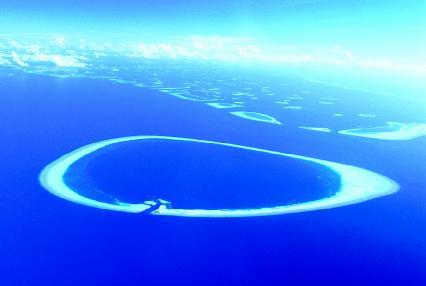
For More Information
Books
Bowen, James, and Margarita Bowen. The Great Barrier Reef: History, Science, Heritage. New York: Cambridge University Press, 2002.
Cerullo, Mary M. Coral Reef: A City That Never Sleeps. New York: Cobblehill, 1996.
Collard, Sneed B. Lizard Island: Science and Scientists on Australia's Great Barrier Reef. New York: Franklin Watts, 2000.
Hook, Cheryl. Coral Reefs. Philadelphia, PA: Chelsea House, 2001.
Massa, Renato. The Coral Reef. Translated by Linda Serio. Austin, TX: Raintree Steck-Vaughn, 1998.
Sheppard, Charles. Coral Reefs: Ecology, Threats, and Conservation. Stillwater, MN: Voyageur Press, 2002.
Web Sites
"About Coral Reefs." U. S. Environmental Protection Agency. http://www.epa.gov/owow/oceans/coral/about.html (accessed on August 14, 2003).
"Coral Reef Ecosystems: Tropical Rain Forest of the Sea." Department of Geology, San Jose State University. http://geosun1.sjsu.edu/~dreed/105/coral.html (accessed on August 14, 2003).
Coral reefs. http://www.starfish.ch/reef/reef.html (accessed on August 14, 2003).
"Coral Reefs and Associated Ecosystems." National Oceanographic Data Center, National Oceanic and Atmospheric Administration. http://www.nodc.noaa.gov/col/projects/coral/Coralhome.html (accessed on August 14, 2003).
"ReefBase: A Global Information System on Coral Reefs." WorldFish Center. http://www.reefbase.org/ (accessed on August 14, 2003).
United States Coral Reef Task Force. http://coralreef.gov/ (accessed on August 14, 2003).
me and my friends are doing a project about them
can you tell us what the bottem of coarl reefs look like
please and thank you